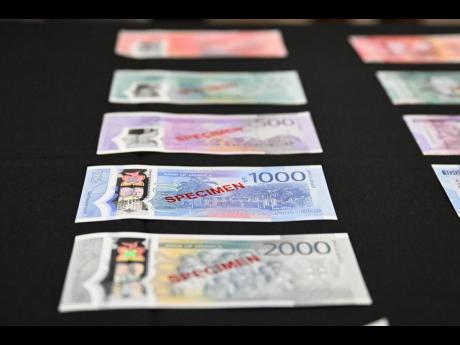The transition to polymer banknotes
Based on the lingering concerns in the public domain regarding the use of polymer, the central bank wishes to reaffirm our confidence in the decision to adopt and introduce polymer banknotes. As the issuing authority for currency, the Bank of Jamaica is committed to providing Jamaicans with high-quality banknotes that are secure against the threat of counterfeiting and facilitate inclusivity, particularly for the visually impaired, as it relates to the distinct recognition and authentication of each denomination.
The bank proceeded with the redesign of the banknote series based on several compelling reasons. These included the fact that the then-existing family of notes made from cotton was more open to counterfeiting. The world standard for improving currency security involves the use of advanced technology in banknote manufacturing on more durable substrates such as polymer, on which sophisticated and long-lasting security features that cannot be easily replicated, are embedded and printed.
Industry experience shows that polymer provides increased security against opportunistic counterfeiting. Available statistics indicate that before introducing polymer banknotes, the Bank of England encountered about 100 counterfeits per one million banknotes in circulation. Since the introduction of polymer, that incidence has been reduced to 23 counterfeits per million banknotes in circulation. The situation is similar for Bank of Canada. Further, in Australia, despite adopting polymer banknotes in the late 1980s, a significant proportion of counterfeit attempts are still made on paper banknotes, due to challenges that criminals have in their attempt to print on polymer. For Jamaica, just prior to the introduction of polymer banknotes, the Bank of Jamaica detected five counterfeits per million banknotes in circulation. Since the introduction of polymer notes in June 2023, however, this statistic has declined to zero.
DURABILITY
Another critical objective of the redesign was to improve the durability of the banknotes. Around the world, note life is measured from the point at which they are put into circulation to the time the central bank removes them from circulation for not being fit for purpose. Existing data show that polymer notes last on average, 2.5 times longer than cotton notes in varying circulation environments, as well as different handling conditions. The new polymer substrate is expected to last up to 50 per cent longer in the Jamaican environment
The longer lifespan on polymer, of tactile features which assist the community of visually impaired people to readily distinguish banknotes of different denominations, was another significant consideration for the use of polymer in Jamaica’s banknotes. In this regard, the leadership of the Jamaica Society for the Blind was instrumental in the process of consultation prior to the decision being taken. Of note, polymer is the only substrate that provides a durable tactile feature.
In the past, many cotton notes have had to be redeemed and destroyed within a short space of time because they were folded, crushed, soiled and/or torn. This was very costly and contributed to expenditure of under $1.0 billion on average per year by the BOJ to replace banknotes. It is in this context that the Bank of Jamaica has embarked upon a public-education campaign encouraging members of the public not to crush, fold, place graffiti on or otherwise damage the polymer banknotes. Already, having printed the current stock of polymer banknotes in 2022, the reprinting of banknotes was eliminated from the central bank’s budget for 2023 and requirements for 2024 are minimal. This is due to the fact that although the initial cost outlay for polymer might be higher relative to cotton, the durability of this substrate far exceeds that of cotton. In this regard, the full cost-savings benefit from the introduction of the more durable polymer substrate for the printing of the new banknote series will be fully realised by next year, and these gains will increase going into the medium term.
NOT UNIQUE
Notably, Jamaica is not unique in having polymer notes existing in climatic conditions that are humid, tropical or having an abundance of moisture. This is in a context of technological advancements that have allowed for the development of cutting-edge printing techniques to support high-quality and long-lasting printing on plastic-type surfaces.
In this regard, to date, 30 per cent of all issuing authorities have transitioned at least one banknote to polymer substrate compared to 14 per cent in 2014. As a result, polymer banknotes now represent 18 per cent of all denominations in circulation around the world relative to eight per cent in 2024.
In addition to more developed countries with temperate climates, such as the United Kingdom and Canada, polymer banknotes exist in many tropical countries including the Maldives, Samoa, the Solomon Islands, Trinidad and Tobago, Barbados, and the Organisation of Eastern Caribbean States-member countries of Anguilla, Antigua and Barbuda, Dominica, Grenada, Montserrat, St Kitts, St. Lucia, and St. Vincent & the Grenadines. In these conditions, the polymer substrate has also had a beneficial impact on the banknote lifetime.
As it relates to the adaptation of automated banking machines, this is not only required when new banknotes are introduced into circulation. Rather, this is necessary once a new banknote denomination in the “same” substrate is introduced into circulation, or when a feature is added to or removed from the banknote series of the day. It is important to note that the Jamaica Bankers Association has reported that nearly all automated banking machines (ABMs) island wide have been retrofitted to accept and issue polymer notes.
With respect to unfit (not fit for circulation) polymer notes, suitable arrangements are in place for the proper and environmentally safe destruction and disposal of these notes.
Finally, the Bank of Jamaica makes no assertions in relation to polymer banknotes that are not supported by the best technical advice and proven experience globally. At the same time, the bank continues to closely monitor the issuance, use and redemption of polymer banknotes and is assessing their performance in the Jamaican context.
Natalie Haynes is the deputy governor with responsibility for financial markets and payments systems at Bank of Jamaica.

